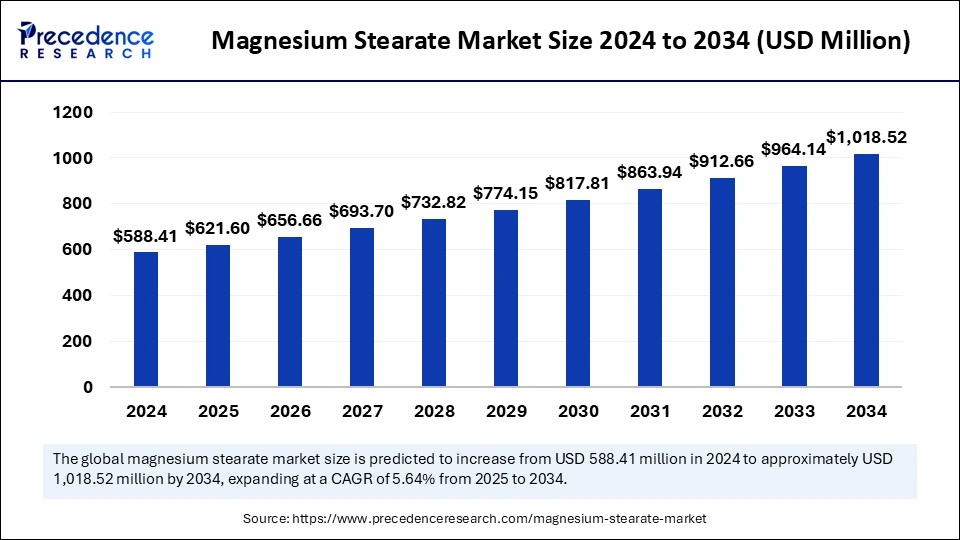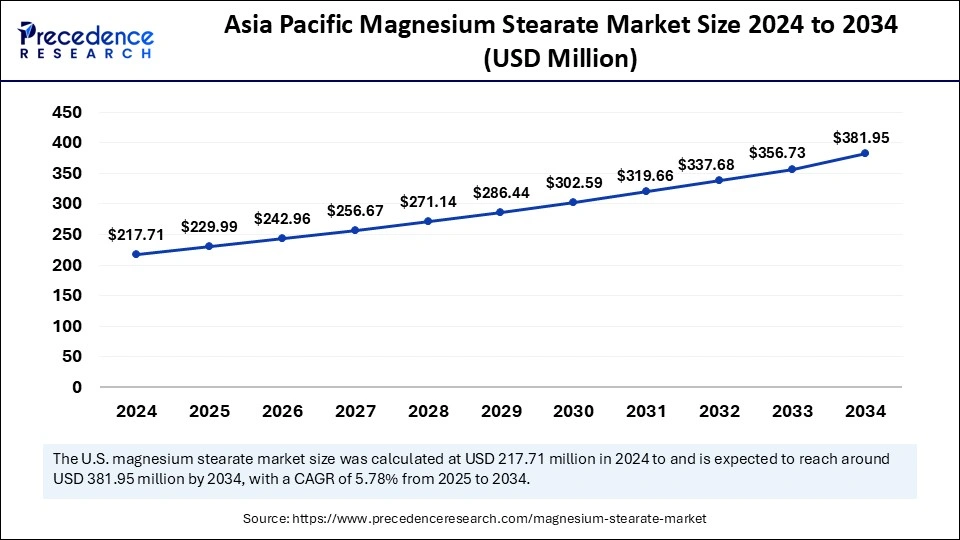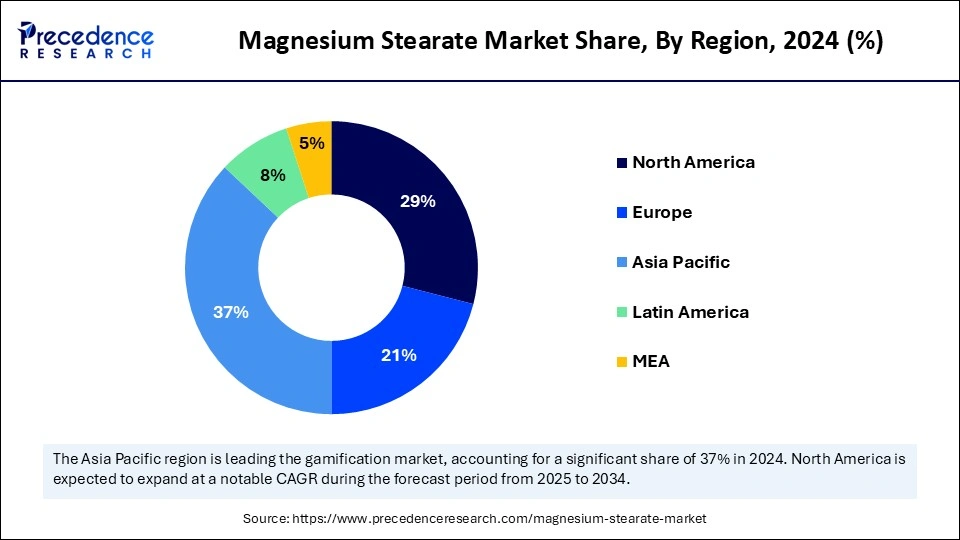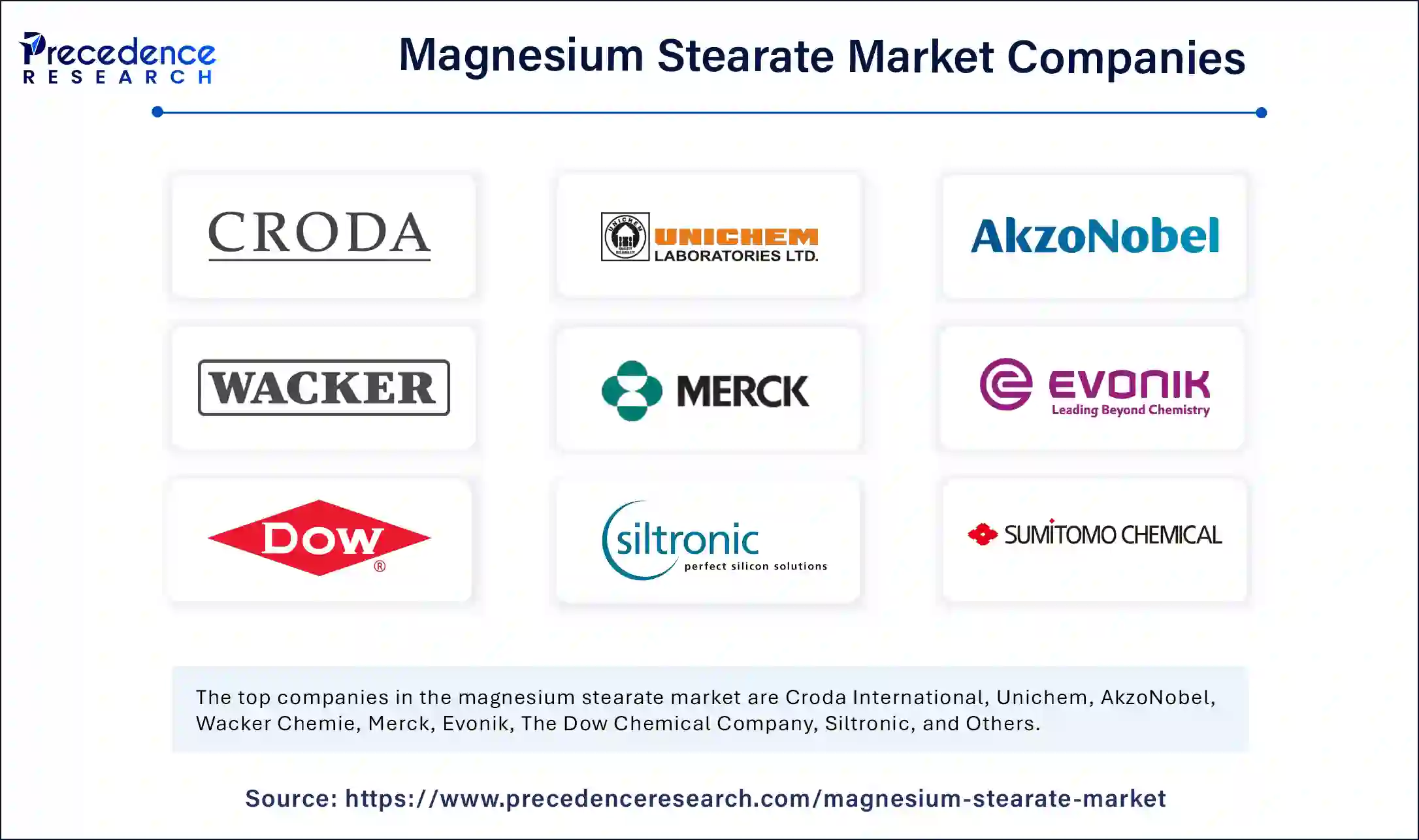February 2025
The global magnesium stearate market size is calculated at USD 621.6 million in 2025 and is forecasted to reach around USD 1,018 million by 2034, accelerating at a CAGR of 5.64% from 2025 to 2034. The Asia Pacific market size surpassed USD 217.71 million in 2024 and is expanding at a CAGR of 5.78% during the forecast period. The market sizing and forecasts are revenue-based (USD Million/Billion), with 2024 as the base year.
The global magnesium stearate market size accounted for USD 588.41 million in 2024 and is predicted to increase from USD 621.6 million in 2025 to approximately USD 1,018 million by 2034, expanding at a CAGR of 5.64% from 2025 to 2034. The market is driven by expanding demand because of its multiple uses as a lubricant, binder, and flow enhancer in pharmaceuticals and personal care products.

Artificial Intelligence technology transforms the magnesium stearate industry because it enhances production efficiency and provides better control over quality standards as well as formulation design improvements. The supply chain and inventory management systems function better due to AI technology, so magnesium stearate products move efficiently through the supply channel. The magnesium stearate market will experience an expansion of its applications throughout industries due to AI evolution, which will lead to innovative products, sustainability improvements, and enhanced personalization for customers.
The Asia Pacific magnesium stearate market size was exhibited at USD 217.71 million in 2024 and is projected to be worth around USD 381.95 million by 2034, growing at a CAGR of 5.78% from 2025 to 2034.

North America held the dominating share of the magnesium stearate market in 2024. The market is expanding through increasing pharmaceutical and dietary supplement production since magnesium stearate functions as a main excipient for tablet and capsule manufacturing through its binding, flow-enhancing, and lubricating properties. The pharmaceutical industry in this region incorporates high-purity magnesium stearate because regulatory compliance demands and specified safety standards for products require them.
The United States possesses a notable position in the North American magnesium stearate market because the pharmaceutical and dietary supplement production sectors significantly drive market requirements. The United States stands as one of the world's largest markets for dietary supplements while needing excipients, including magnesium stearate, to produce uniform and high-quality tablets and capsules for its customers.

Asia Pacific is expected to witness the fastest growth in the magnesium stearate market during the predicted timeframe. The region's investment advantages and proactive governmental backing of food production, pharmaceuticals, and cosmetics industries drive regional development. The worldwide expansion of nations, including China, India, Malaysia, Indonesia, and Thailand, will lead to increased magnesium stearate requirements within processed food and pharmaceutical industries.
The Indian magnesium stearate market stands as an essential force behind market expansion in Asia Pacific because its pharmaceutical and food processing sectors keep expanding. The pharmaceutical industry within the country is expanding strongly because it consumes magnesium stearate primarily as a tablet production component for binding, lubrication, and flow enhancement functions. The growing interest in dietary supplements, along with enhanced health awareness, drives up the need for magnesium stearate as an active ingredient.
India Brand Equity Foundation projects the pharmaceutical sector to reach USD 100 billion by 2025 and the medical device market to arrive at USD 25 billion by the same year. The exports of Indian pharmaceutical products reached USD 16.3 billion during the year FY20.
The European magnesium stearate market continues to expand because of the growing pharmaceutical and personal care industries. High-quality production standards in the region enforce the use of magnesium stearate as an excipient in pharmaceutical productions and dietary supplement manufacturing, which drives market growth. The rising European interest in organic and natural cosmetics supports the market adoption of magnesium stearate as a naturally derived excipient. The European market continues to expand its position in the global market because of intensifying company requirements for quality, safety, and regulatory compliance.
Magnesium stearate presents as a smooth white powder with a slippery texture and finds extensive usage in pharmaceuticals, cosmetics, and dietary supplements. The hydrophilic salt magnesium stearate forms through the reaction between magnesium and stearic acid to generate an adaptive material that exhibits lubricating properties. Magnesium stearate market applications enables the efficient production of pharmaceutical products, which includes tablets and capsules, as well as powders for the pharmaceutical industry.
Magnesium stearate usage continues to grow because it functions as a key ingredient that drives up the demand for pharmaceuticals and dietary supplements. Expanding cosmetics industry trends boost the market because magnesium stearate serves as an additive in several items, such as makeup formulations and personal care products. The market grows because pharmaceutical manufacturers use better production methods with rising efficiency and cost-effectiveness requirements.
| Report Coverage | Details |
| Market Size by 2034 | USD 1,018.52 Million |
| Market Size in 2025 | USD 621.6 Million |
| Market Size in 2024 | USD 588.41 Million |
| Market Growth Rate from 2025 to 2034 | CAGR of 5.64% |
| Dominated Region | Asia Pacific |
| Fastest Growing Market | North America |
| Base Year | 2024 |
| Forecast Period | 2025 to 2034 |
| Segments Covered | Form, Application, and Regions |
| Regions Covered | North America, Europe, Asia-Pacific, Latin America and Middle East & Africa |
Rising demand for personal care and cosmetics
The industry demand for the magnesium stearate market is steadily increasing for its use as a thickening binding and anti-caking agent in personal care and cosmetic products. The cosmetic industry depends on magnesium stearate as an essential agent which helps maintain foundations and eyeshadows, blusher products and lipstick formulations stable with their optimal texture while also ensuring smooth application. The rising consumer interest in high-quality beauty products, particularly in emerging markets, sustains the essential role of magnesium stearate as an active ingredient.
The market demand for magnesium stearate increases because consumers show a rising interest in natural and organic cosmetic products. As a naturally derived ingredient, magnesium stearate addresses market needs through eco-friendly, sustainable goods that protect users' health and align with their demand for organic materials. The market expands because magnesium stearate plays an essential function in personal care products, which makes this sector more important.
Stringent regulatory environment and safety concerns
The magnesium stearate market faces obstacles such as a strict regulatory environment and safety concerns. Product adoption of magnesium stearate exists under strict boundaries set by the Federal Drug Administration (FDA) and European Medicines Agency (EMA) established regulatory standards and compliance regulations. The regulatory bodies enforce specific restrictions regarding the acceptable amount of magnesium stearate usage that apply to food products, pharmaceutical medicines, and personal care products throughout various industries. The regulations create manufacturing limitations for companies to handle extensive documentation procedures followed by multiple quality tests and required approvals that lead to higher production expenses and delayed market releases.
Increasing demand for natural and organic products
The growing customer interest in natural organic products particularly affects personal care products and dietary supplements. The rising market interest in organic cosmetics prompts an enhanced use of magnesium stearate due to its fundamental role in maintaining product texture and stability and delivering silky consistency to cosmetics. The pharmaceutical industry and nutraceutical sector experience ongoing growth from natural health product demand, thus creating more possibilities for magnesium stearate applications within supplements and processed drugs.
The powder segment will have the largest magnesium stearate market share in 2024. Magnesium stearate powder maintains excellent compatibility for tableting processes, thus making it suitable for tablet and capsule manufacturing operations as a lubricant, flow enhancer, and binder. The smooth manufacturing process becomes achievable due to its fine texture, which effectively decreases equipment friction so ingredients remain free of adherence.
The powder nature of magnesium stearate makes it easy to combine it with pharmaceutical agents while maintaining exact dosage consistency. The pharmaceutical industry uses this ingredient because it enables the efficient production of dietary supplements by enhancing the flowable properties and consistency of powders.
The flakes segment is anticipated to show considerable growth in the market over the forecast period. The manufacturing industry uses magnesium stearate flakes when controlled delayed delivery functions are required. The formulation-friendly properties and user-friendly characteristics of magnesium stearate flakes prove beneficial to cosmetics companies with producers of food products, and pharmaceutical manufacturers because they emphasize texture control and product stability.
The cosmetic industry employs magnesium stearate flakes as texturizing elements to enhance spreadability as well as create smoother particle systems in their formulations. The increasing need for different applications of alternative magnesium stearate derivatives combined with customer-driven product development will fuel the growth of the flakes segment.
The pharmaceutical segment contributed the largest share of the magnesium stearate market in 2024 due to its critical role as an excipient in drug manufacturing. Pharmaceutical producers utilize magnesium stearate as a lubricant with a binder and flow enhancer to develop tablets and capsules, which produce manufacturing activities that run smoothly and efficiently. Its lubrication functions work to stop ingredients from adhering to manufacturing tools, and its binding property maintains tablet structural stability.
The filling properties of magnesium stearate improve the quality and uniformity of the finished pharmaceutical products. Both the growing use of nutraceuticals and dietary supplements and the increasing focus on high-quality excipients will enhance the market for pharmaceutical-grade magnesium stearate. Regulatory requirements for high-purity safe pharmaceutical ingredients convince manufacturers to incorporate magnesium stearate into their formulations, thus making it essential for pharmaceutical applications.
The personal care segment is expected to witness significant growth in the market during the forecast period. The use of magnesium stearate in skincare formulations, products, and toiletry items drives potential market expansion. The personal care industry depends substantially on magnesium stearate due to its multi-functional role as an absorbent, thickener, anti-caking agent, and texturizer in creams, lotions, foundations, and powder products.
Magnesium stearate has gained popularity because increasing numbers of consumers want products containing natural transparent ingredients. The rising concern about safety in skincare ingredients and cosmetic products aggressively drives up the demand for magnesium stearate. The rising market emphasis on sustainable and eco-friendly personal care formulations enables magnesium stearate to establish stronger market prospects.

By Form
By Application
By Geography
For inquiries regarding discounts, bulk purchases, or customization requests, please contact us at sales@precedenceresearch.com
No cookie-cutter, only authentic analysis – take the 1st step to become a Precedence Research client
February 2025